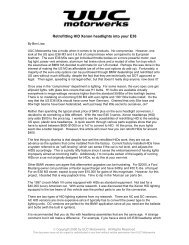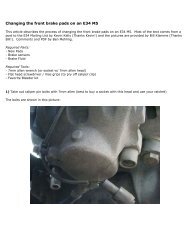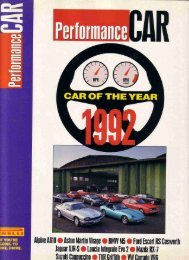Tech - Xenon Lights.pdf
Tech - Xenon Lights.pdf
Tech - Xenon Lights.pdf
You also want an ePaper? Increase the reach of your titles
YUMPU automatically turns print PDFs into web optimized ePapers that Google loves.
HANDS ON41Converting a late-model BMW to <strong>Xenon</strong> lighting is a simple plug-injob, but what about older cars? We find a kit that does the job.Shifting down the outside lane in a worldof your own and suddenly from behindyou see bright white lights with an intermittentblue flicker. Instinctively, your heartskips a beat, you switch off the cruise control,drift into the second lane and resignyourself to the fact that, unless they’re withinhalf an hour of the end of their shift,you’re about to see some even bluer lightsand quite a bit of hard shoulder.As the car pulls alongside, you lookacross in anticipation of the usual patronisinggesture, only to see some marketingdirector type in a new 7-Series, making hisway unconsciously home to the Berkshireburbs. His car has a <strong>Xenon</strong> lighting system,the most significant technological advancein automobile lighting since tungsten bulbsgave way to halogen. But what exactly is<strong>Xenon</strong> lighting and how does it differ fromthe conventional halogen headlamp?We got in touch with CA Automotive(01252 792572), expert in the field of whitelight, which was not only able to blind uswith the necessary science, but also todemonstrate the process of convertinghalogen headlamps to <strong>Xenon</strong>. We first needto familiarise ourselves with a bit of jargon,though, in order to appreciate the benefitsof such an upgrade.The same system is also referred to asHID (High Intensity Discharge) lighting. Theobvious advantage is that it’s much brighterthan halogen, but to effectively measurebrightness, and other inherent qualities oflight, bulb boffins use recognised units suchas Candela, Lumen and Kelvin. Candela (fromthe word candle) is a measure of light intensity, concerned in particular with spread andreach. Lumen is the unit used for calculatingluminous flux (the bundling of the light) andKelvins indicate thermodynamic temperatureor colour temperature (whiteness).The table below outlines the benefits: CAAutomotive supplies and fits — if required— the Target UltraVision <strong>Xenon</strong> conversion.If you’re a competent DIY mechanic youshouldn’t have any problems, although Royat CA Automotive will happily assist with anytechnical enquiries over the phone. Kits areavailable for high beam conversions as well,but Roy is quick to point out that great caremust be taken if you fit them, because theywill seriously dazzle oncoming traffic.The guinea pig vehicle is our 1996model E34 520i. The conversion isbasically the same for most BMW models,although the removal of certain componentsto provide the necessary accessmay vary. Guiding us carefully through thes t e p - b y-step procedure of installation isauto electrical expert, Giles. He works forChesterfield-based Auto Select, which actsas fitter on behalf of CA Automotive for itsmore northern-based customers.H A L O G E N H 1 X E N O N H 1 S U N L I G H TWattage (W) 55 35 N / ACandela (CD) 67 , 500 202 , 500 i n f i n i t eLumen (Lm) 1500 3200 8400Kelvin (K) 3200 4100 6000Light Colour y e l l o w / w h i t e pure white N / AL i f e t i m e 400 hours 3200 hours h m m m ...Words: Barton BrislandP H O T O G R A P H Y: MICHAEL WHITESTONE
42HANDS ON0102040305SAFETYThe first rule of working on cars and using tools of any kind isdon’t take risks:• If you’re using power tools, protective gear is essential.• Never work under a car without supporting it using axlestands first.• When cars catch fire, they burn fast. Always have a fireextinguisher to hand.• If you’re not completely confident in your own ability tocomplete any task safely, don’t even start it. Leave it tothe ex p e r t s .The advice and guidelines given in Total BMW magazine aregiven in good faith and neither Total BMW nor A&S Publishingcan take any responsibility for injuries sustained while carry i n gout the described tasks and procedures, or any consequencesarising therefrom.Starting with the nearside lamp on Nick’s E34, the power steering fluid reser-needs to be loosened. It isn’t necessary to disconnect the hoses and spill1voirfluid everywhere, though. Removing the two 10 mm bolts and tucking the reservoiras far out of the way as possible is sufficient to gain access.The airbox is in the way too. There’s a coolant temperature sender which2needs undoing first, then the 10 mm fastening bolts which locate the box onthe inner wing can be removed, along with the induction hose to the air flowmeter. Then the entire assembly can be lifted out of the way.Next, remove the plastic cover from the back of the light. There are3two screws on top of the cover which need just a quarter of a turnto release them.Disconnect the two-pin electrical connector from the back of the light unit4(it’s obviously the outer of the two lights that we’re referring to here, as we’reonly concerned with the low-beam conversion)...
4306070809 10... and pull off the round black/grey cover that you’ve just unplugged. You can5 now see the base of the standard halogen bulb. Unclip it from its mounting anddiscard it.The round plastic cover/connector is retained for the conversion and here’s6where you need to adapt it to suit: using a drill with a 25 mm hole cutterattachment, find the exact centre of the cover and then cut it out. Use a decent bitand let the drill do the work. Take care not to apply too much downward pressurewhich could crack the cover/connector.Take one of the <strong>Xenon</strong> bulbs from the Target UltraVision kit. Remove the plasticcover from the glass of the bulb (take care, as <strong>Xenon</strong> bulbs are extremely7expensive to replace, although they aren’t particularly affected by skin contact,unlike halogens). Here you see the bulb with its integral cable tree. The insulatedconnectors at the bottom of the picture will be wired, in circuit, to the remainingcomponents in the kit, but pay particular attention for now, to the two wires withmale spade ends protruding from the bulb-side of the insulating grommet.Giles is now feeding the <strong>Xenon</strong> bulb and cables through the cover/connector8from the rear. The bulb obviously has to be on the inside, but note also that thetwo spade-ended wires do as well, while the insulating grommet and aftermarketplugs and connectors are left protruding from the rear.The spade-ended wires connect up to female terminals — which are part of9the car’s original wiring harness — on the inside of the now modifiedcover/connector. The red wire is of course live and the black, earth. This is howthe conversion taps into the existing 12V power supply.Here you can see the electrical plug fitting, which is now connected up to10the <strong>Xenon</strong> bulb via the two spade-ended wires. Giles is pulling the slack inthe wires out through the back of the cover/connector and fitting the grommet fora watertight seal.
44HANDS ON1112 131514What It CostsTarget Ultravision <strong>Xenon</strong> low beam conversion kit £ 525Dual beam kit £ 800The <strong>Xenon</strong> bulb has the same shaped metal base as the halogen item that11it replaces. Because of this, it fits straight into the light unit and is securedusing the standard retaining clip. Fit the bulb, replace the cover/connector andreconnect the standard electrics.Now we need to fit the igniter and the high voltage convertor. Unlike the12 halogen bulb, with a filament, the <strong>Xenon</strong> bulb is filled with gas (<strong>Xenon</strong>gas, as you’ve probably figured out for yourself by now). <strong>Xenon</strong> gas remains inertuntil it’s charged with something in the region of 24,000V, and this is why youneed an igniter.This is the igniter control box — 12V go in and 24,000 come out the other13side (hence the thick insulation around the wire on the left of the box).This amount of current is only used to activate the <strong>Xenon</strong>, after which time thelight source can be maintained with a much lower voltage (approx 400V). It doesn’treally matter which way up or around you choose to mount the igniter, but keepit as far from other sources of heat (ie, exhaust manifold, turbo etc) as possible.Do not shorten or lengthen any of the wires between the igniter and the bulb. Theirprecise length determines their resistance, so that even as little as an inch eitherway will vary the output by several thousand volts. The back of the igniter has aself-adhesive pad which will adequately secure it to any painted surface, as longas it’s clean and dry.This is the high voltage convertor or ballast box, which provides the lower14current needed to run the lights once the igniter’s done its job. Too big forsticky pads, the box is secured using the three lugs about its perimeter. Offer it upinto a suitable position where all the lugs can be used to locate it securely. Use apunch or rivet to mark where to drill. As with the igniter, it must be kept cool. Nutsand pan head bolts are the ideal fix, but if you’re going to use self-tappers with theconvertor mounted on the inner wing, beware that the points of the screws will protrudetowards your tyres. Use any screws longer than 0.75 inches and you’ll need tojack up the car, remove the front wheels and grind off the points of the screws.The wires and plugs provided to connect up the bulbs, igniters and ballast15 boxes are designed so that they cannot be incorrectly routed. Ta ke your timeand don’t force anything. If you’ve carried out all the steps correctly then you shouldnow have <strong>Xenon</strong>-powered, high intensity discharge headlights. They take a momentto warm up so don’t expect instant miracles, but you should see an immediateimprovement when you compare them to your old high beams. New bulbs requirehours of use before they achieve their peak thermodynamic efficiency, or in otherwords, they continue to burn more and more white for the first few weeks.ContactCA Automotive01252 792572w w w. c a - a u t o m o t i v e . c o . u k








